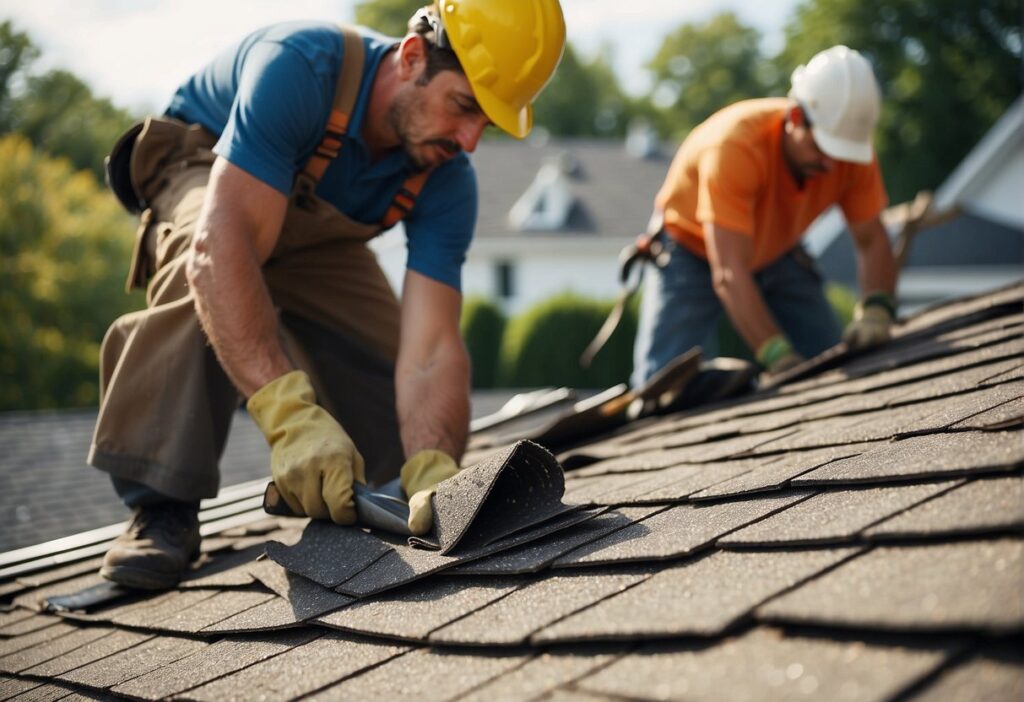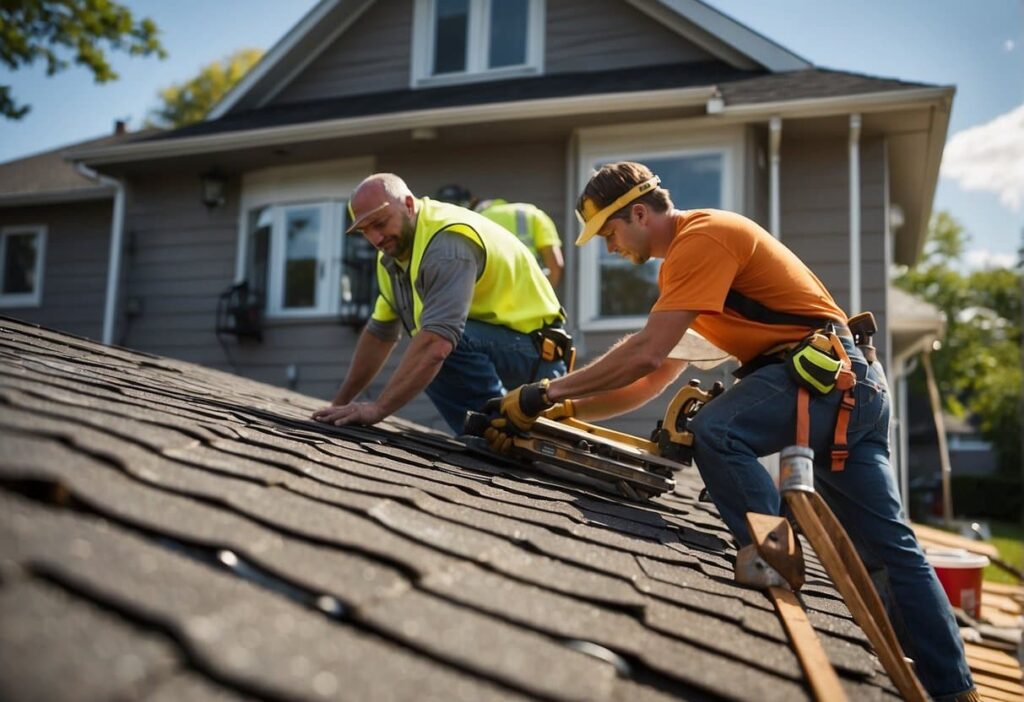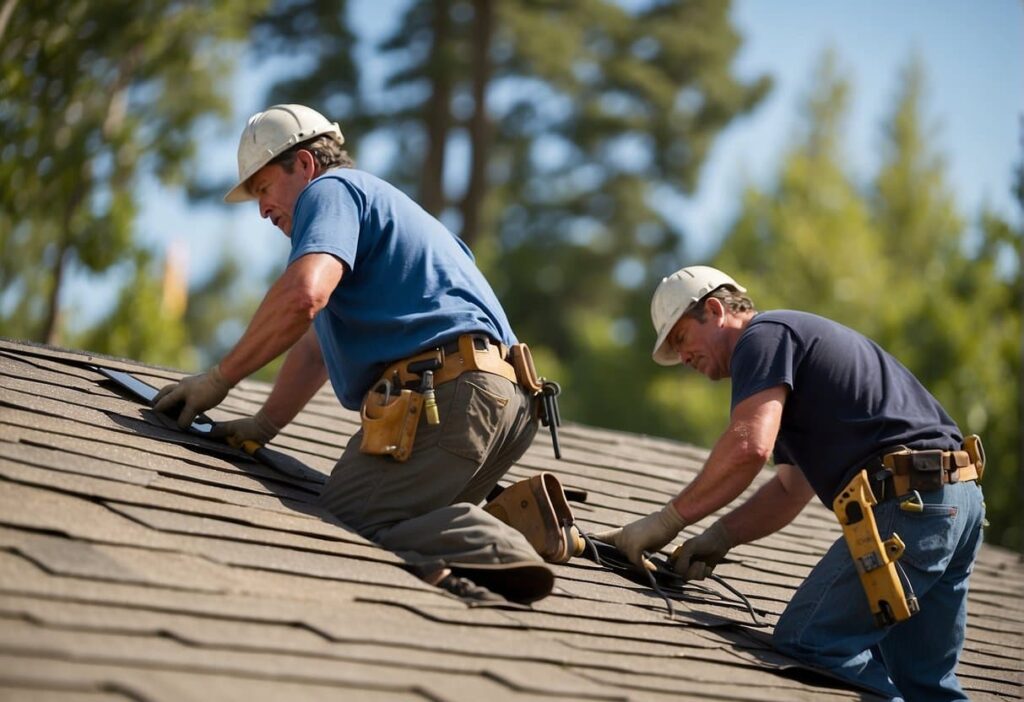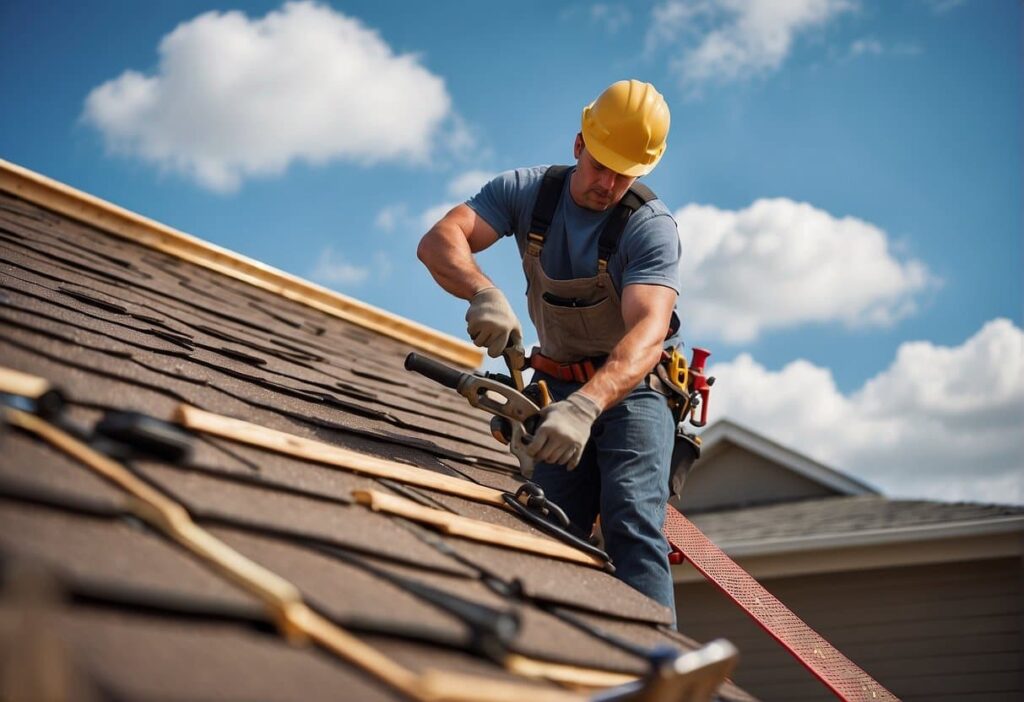Roof Replacement: Essential Tips and Cost-saving Strategies
Roof replacement is an essential aspect of maintaining a home and protecting one’s investment. Over time, roofs can wear down due to various factors such as weather conditions, wear and tear, and age. When a roof reaches the end of its lifespan, it becomes more susceptible to damage and leaks that can impact the overall safety, efficiency, and value of a home.

As a homeowner, understanding the importance of roof replacement and knowing when it is needed can make a significant difference in maintaining the integrity and protection of the home. This not only ensures that the property remains in good condition but also helps to avoid costly repairs and potential damage caused by a failing roof.
In this article, we will explore the key factors to consider when determining the need for a roof replacement, as well as guide the process involved. By remaining informed and proactive about roof maintenance, homeowners can ensure their investment remains secure and well-protected for years to come.
Determining the Need for Replacement
Assessing Roof Damage
One of the primary responsibilities of homeowners is to ensure the structural integrity of their roofs. A thorough inspection of your roof is crucial in determining whether to opt for roof repair or replacement. To begin, check for common issues such as leaks, storm damage, and the general state of your roof shingles.
It’s essential to consider the lifespan and age of your roof. Different materials have varying lifespans, such as:
- Asphalt shingles: 15-30 years
- Metal roofing: 30-50 years
- Slate or clay tiles: 50-100 years
Regular inspection of the flashing around vents, chimneys, and other roof penetrations is also necessary, as these areas are prone to leaks and damage.
Signs of Roof Wear
Several visible signs indicate the need for roof replacement. Here are some key indicators to look for during your inspection:
- Granule loss: Excessive loss of granules on asphalt shingles is a sign of wear, as they protect against UV rays and provide fire resistance.
- Curling or buckling shingles: Shingles that curl or buckle indicate potential leakage points and could be nearing the end of their lifespan.
- Missing or damaged shingles: If you find any missing or damaged shingles, it’s essential to address the issue promptly. Repairs are often possible, but widespread damage may call for a full replacement.
- Sagging roof: A sagging roof is a severe issue that usually indicates structural problems and requires immediate attention.
Homeowners should also be aware of less visible signs such as:
- Mold or mildew growth
- Water stains on interior ceilings or walls
- Higher energy bills due to poor insulation
In conclusion, the key to maintaining a structurally sound roof is through regular inspection and addressing issues promptly. By assessing damage and looking for signs of wear, homeowners can make an informed decision on whether to repair or replace their roofs to ensure their longevity and the overall safety of their homes.
Roofing Materials Overview
Comparison of Material Types
When it comes to roofing materials, there are several popular and eco-friendly options available in the market. Some of the common materials include asphalt shingles, metal roofs, slate tiles, wood, and clay tiles. A brief comparison of these materials is shown in the following table:
| Material | Energy Efficiency | Eco-friendliness | Durability | Aesthetics |
| Asphalt Shingles | Moderate | Moderate | Low | Moderate |
| Metal Roof | High | High | High | High |
| Slate Tiles | Low | High | High | High |
| Wood | Moderate | High | Moderate | High |
| Clay Tiles | Moderate | High | High | High |
As evident from the table, metal roofs and slate tiles tend to score higher in terms of energy efficiency and durability. However, the choice of material will be influenced by several factors such as budget, climate, and personal preference.
Factors Affecting Durability
Several factors affect the durability of roofing materials. Some of these factors include:
- Climate: The local climate has a significant impact on the longevity and performance of roofing materials. For example, asphalt shingles may perform better in colder climates, while clay tiles are more suited for warmer climates.
- Quality of Installation: A professional and accurate installation will ensure that the roofing material performs well and lasts longer. In contrast, poor installation can reduce the material’s lifespan and increase the risk of damage.
- Maintenance: Regular maintenance, such as cleaning and inspection, can prolong the life of roofing materials. Failure to maintain the roof can lead to a buildup of debris and moisture, which can cause damage over time.
In conclusion, it is essential to consider the different roofing materials available and the factors affecting their performance before making a decision. By doing so, homeowners can select a material that best suits their needs and ensures a durable, energy-efficient, and eco-friendly roof.
Cost Considerations

Estimating Roof Replacement Costs
When planning for a roof replacement, it’s important to first estimate the overall cost of the project. This can typically be calculated by considering factors such as roof size, material choice, and labour costs. One popular method for approximating roofing costs is using the cost per square foot. For example, an asphalt shingle roof’s cost may range between $3.50 and $5.50 per square foot, whereas metal roofing may range from $5.50 to $12 per square foot.
Keep in mind that costs can vary greatly based on the complexity of the project, and the specific materials used. It’s beneficial to gather multiple quotes from various contractors to find the best value.
Budgeting for Roof Replacement
To ensure that your roof replacement is a sound investment, it’s crucial to set a realistic budget for the project. To do this, consider the following factors:
- Average cost: Researching the average cost of roof replacements in your area can provide a good baseline for your budget.
- Cost of living: Areas with higher costs of living may have increased labour and material costs.
- Payment options: Determine if financing is available, and if it’s a viable option for your situation. Some contractors offer in-house financing, while others may accept credit cards or personal loans.
By having a clear understanding of these factors, you can better allocate funds for your roofing project and avoid any unforeseen expenses.
Hidden Expenses in Roofing Projects
Aside from the primary costs associated with roof replacements, there may be additional, hidden costs to consider. Some of these can include:
- Removal and disposal: Some contractors may charge extra for the removal and disposal of your old roof, ranging from $1 to $5 per square foot.
- Permit requirements: Depending on your location and specific project, there may be additional fees for permits or inspections required by your local government.
- Zip code: Roofing material prices can vary depending on the region, meaning one material may be more cost-effective in a different zip code.
- Unexpected costs: Occasionally, the contractor may discover underlying issues such as damaged wood decking or rotted fascia boards that may increase the cost of the project.
Be sure to discuss these potential hidden expenses with your contractor to avoid any surprises and adjust your budget accordingly.
Choosing a Roofing Contractor

Evaluating Contractor Expertise
When it comes to replacing your roof, selecting the right roofing contractor is essential. Take time to research a few roofers in your area and carefully evaluate their expertise in handling your specific roofing needs. One crucial factor to assess is a contractor’s experience in re-roofing. Longer-term experience helps ensure that the contractor can handle various challenges that may arise during roof replacement.
It is best to specifically look for a professional roofing contractor who has the necessary certifications and memberships for added assurance of their quality of work. Well-known groups that certify roofers. CD Roofing & Construction Ltd. are PLATINUM installers for BP Shingles. Look for a contractor affiliated with an organization that certifies roofers to ensure you’re getting the highest quality install.
Here are some key pointers to evaluate a contractor’s expertise:
- Years of experience
- Certifications and affiliations
- Previous projects and customer reviews
- Insurance coverage for both the workers and your property
Understanding Contractor Quotations
Various contractors will provide different estimates before undertaking the roof replacement project. While it may be tempting to choose the contractor with the lowest price, this may not always prove to be the best decision. Instead, carefully analyze each contractor’s quotation and compare them based on the following factors:
- Roof installation method: Will they remove the old shingles or install new ones on top?
- Installation cost: Is the price within your budget and does it include all necessary materials?
- Warranty: Does the contractor offer a warranty for their work, and is it a reasonable length of time?
Here’s an example of how to compare contractor estimates in a table format:
| Contractor | Installation Method | Installation Cost | Warranty |
| Roofer A | Remove old shingles | $10,000 | 5 years |
| Roofer B | Install over old | $8,500 | 3 years |
| Roofer C | Remove old shingles | $11,000 | 10 years |
Remember that a good roofing contractor should always prioritize quality and long-term benefits for your property. It is essential to consider factors such as the installation method, costs, and warranty when deciding on the right roofer for your project.
Preparation and Installation Process

Preparing Your Home for Roof Replacement
Before installing a new roof, it is important to prepare your home. This includes taking steps to protect your property and ensuring a smooth installation process. First, clear the area around your home, removing any objects that may pose a risk during installation.
Next, inspect the roof deck and ensure it has no damaged areas that might prevent proper installation. Replace any damaged portions before proceeding. Install the necessary components, such as:
- Underlayment: A layer of material is installed between the roof and its outer covering to provide additional protection.
- Flashings: Thin metal sheets are applied to vulnerable areas to prevent water infiltration and damage.
- Ridge vent: Installed at the peak of the roof, this vent helps to regulate temperature and humidity in your attic.
- Drip edge: Placed along the eaves, this metal strip aids in directing water away from the roof, protecting its edges.
Installation Techniques and Timeline
The actual installation process for your new roof will depend on several factors, including the type of material chosen, the pitch and complexity of your roof, and the installation methods employed by your chosen contractor. Despite these variations, the following steps are common in most roof installations:
- Remove existing roof: Professionals will carefully remove the old roof, ensuring no damage occurs to your home or property.
- Inspect roof deck: Following removal, the roof deck is inspected for damage, and any necessary repairs are performed.
- Lay down underlayment: Installers place underlayment over the roof deck to protect against water infiltration.
- Install flashings and drip edge: These components are put in place to guard vulnerable areas from potential damage due to water or debris.
- Install new roofing material: The chosen material, whether it be asphalt shingles, metal, or another option, is installed on the roof in line with industry best practices and manufacturer recommendations.
- Install ridge vent: In the final step, the ridge vent is installed to aid in proper attic ventilation.
When estimating the installation timeline, consider the following variables:
| Factor | Impact on Timeline |
| Roof Size | Larger roofs require more time. |
| Roof Material | Some materials take longer to install than others. |
| Complexity | Roofs with unique shapes or challenging access points may take longer to install. |
| Weather Conditions | Poor weather can delay installation. |
In general, most roof installations can be completed within a few days. However, it’s crucial to maintain communication with your contractor to ensure a successful installation.
Post-Installation Considerations

Dealing with Maintenance and Repairs
After the installation of a residential roof, it’s crucial to stay proactive about its maintenance and repairs to ensure a longer lifespan and preserve the value of your investment. Regular maintenance can help prevent potential issues such as leaks and damage caused by high winds.
- Regular inspections: Conduct biannual inspections after major storms to identify any potential weak points, damaged shingles, or leaks.
- Gutter maintenance: Clean gutters and downspouts regularly to prevent water buildup and potential damage to the roof’s structure.
- Tree trimming: Cut back overhanging branches to reduce the potential for debris buildup and damage.
- Addressing leaks: If leaks are detected, address them promptly to minimize risks of further damage.
| Potential Issue | Maintenance Task |
| Damaged or missing shingles | Replace or repair promptly |
| Leaks, water stains, or mould growth | Identify source, repair if necessary |
| Debris buildup in gutters | Clear debris, ensure proper flow |
Assessing Warranty and Protection Plans
Considering the significance of your roof replacement as an investment, it’s important to evaluate the warranty and protection plans available. These plans safeguard and help maintain the value of your renovation project.
Manufacturer’s Warranty: The manufacturer’s warranty generally covers defects in the roofing material. It’s important to understand the terms of the warranty, such as its duration and what constitutes a defect.
Workmanship Warranty: Roofing contractors may provide a warranty on their work, covering the installation process. This warranty can vary in duration, ranging from a few years to the lifespan of the roof.
Insurance: Homeowner’s insurance policies can cover roof damage, subject to the terms and limits of your policy. Discuss your coverage options with your insurance provider.
In conclusion, routine maintenance and properly assessing warranty and protection plans can help preserve the value of your roof replacement while ensuring its longevity. Stay proactive to maximize the return on your investment and protect your home.
Location and Climate Factors

When considering a roof replacement, it’s essential to take into account the location and climate factors of your home. These factors will impact the materials you’ll choose, as well as the preparations needed for seasonal challenges.
Selecting Materials for Weather Resistance
It’s crucial to select roofing materials that will stand up to the weather and climate conditions in your area. Here’s a brief overview of some popular roofing options and their suitability for different environments:
- Slate Roof: Provides excellent long-term durability and resistance to storm damage, fire, mould, and moisture. It’s especially suitable for colder climates prone to heavy snowfall, as it easily sheds snow and ice.
- Metal Roofs: Ideal for regions with constant exposure to strong winds, rain, and hail, as they are resistant to corrosion and impact damage. They are often used in coastal areas, thanks to their ability to withstand saltwater corrosion.
- Asphalt Shingles: One of the most popular roofing options for their affordability and adaptability to a wide range of climates. They provide reasonable weather resistance against storms and high temperatures but might require more frequent maintenance and replacement compared to other materials.
It’s also essential to consider local building codes, which might dictate specific materials or safety measures required for your area. Compliance with these codes will ensure that your roof replacement meets your location’s safety standards.
Preparing for Seasonal Challenges
Depending on your location, seasonal challenges such as harsh winter weather or strong storms can significantly impact your roof’s longevity and performance.
For homeowners in colder climates, it’s important to prepare your roof for winter by implementing safety measures such as ice barriers. These barriers help prevent ice dams from forming, which can cause leaks and structural damage to your roof. Moreover, proper insulation and ventilation are crucial in maintaining a consistent temperature throughout your home and reducing the risk of ice dam formation.
In storm-prone areas, regular inspection and maintenance become even more critical. It’s essential to check for loose or damaged shingles and ensure that your roof has proper flashing and sealant to prevent water intrusion. Additionally, consider installing hurricane clips or straps to further protect your roof from high winds and storm damage.
In conclusion, recognizing the importance of location and climate factors in your roof replacement decision-making process is crucial to achieving long-term performance and maximizing your investment. By selecting the appropriate materials and preparing for seasonal challenges, you can ensure that your new roof will stand up to the local elements and provide safety and comfort for your home.
Frequently Asked Questions

How are roof replacement costs estimated?
Roof replacement costs are typically estimated by considering factors such as the type and quality of materials used, labour costs, and the size of the roof. Additional costs may arise from any required structural repairs or modifications to the roof deck. The final price will vary depending on the chosen contractor and the region in which the roof replacement takes place.
What are the most cost-effective materials for roof replacement?
Asphalt shingles remain the most popular and cost-effective choice for roof replacement, due to their affordability and ease of installation. However, other materials, such as metal, wood, and clay or concrete tiles, have their benefits in specific climates or aesthetics. Ultimately, the cost-effectiveness of a material should be evaluated in terms of durability and required maintenance.
What is generally included in a full roof replacement service?
A full roof replacement service typically includes the removal and disposal of existing roofing materials, inspection of the roof decking for damage or rot, installation of new roofing materials, and sealing and flashing installation to prevent water leakage. Some roofing contractors may offer additional services, such as gutter and vent replacement, as part of their package.
How can I find reliable roof replacement services in my area?
To find reliable roof replacement services in your area, start by asking for recommendations from friends or family, and check online review platforms for user experiences with local contractors. It’s essential to confirm that the contractor you choose is properly licensed, insured, and experienced in your chosen roofing material. Requesting multiple quotes and conducting research on their workmanship can further ensure you choose the right contractor for your roof replacement project.
How does the size of the roof impact the overall replacement cost?
The size of the roof directly affects the overall replacement cost, as roofing materials and labour are typically calculated per square foot. Larger roofs require more materials, labour, and disposal of existing materials, resulting in a higher overall cost. However, it’s important to note that some contractors may offer discounts for larger projects, which can offset some of the increased costs.
What should I expect during the roof replacement process when filing an insurance claim?
When filing an insurance claim for a roof replacement, the first step is to contact your insurance provider to understand the process and coverage details that apply to your specific situation. Most insurance companies require an inspection and damage assessment to determine the extent of the claim. Once approved, your insurance will typically cover the cost of replacing the damaged roofing materials, minus any applicable deductibles. It’s crucial to work closely with your chosen contractor throughout the process, ensuring that they meet your insurance company’s requirements and provide prompt communication regarding any updates or changes to the project scope.
